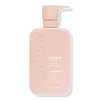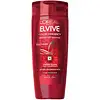What's inside
What's inside
 Key Ingredients
Key Ingredients

 Benefits
Benefits

 Concerns
Concerns

 Ingredients Side-by-side
Ingredients Side-by-side

Water
Skin ConditioningCocamidopropyl Betaine
CleansingDisodium Laureth Sulfosuccinate
CleansingSodium Cocoyl Isethionate
CleansingGlycerin
HumectantSodium Chloride
MaskingAcrylates Copolymer
Phenoxyethanol
PreservativeCocamide Mipa
EmulsifyingSodium Lauroyl Sarcosinate
CleansingSodium Benzoate
MaskingGlycol Distearate
EmollientParfum
MaskingPolyquaternium-10
Hydroxypropyl Guar Hydroxypropyltrimonium Chloride
Cocos Nucifera Oil
MaskingGlyceryl Oleate
EmollientCoco-Glucoside
CleansingPolyquaternium-7
Polyquaternium-11
Benzyl Alcohol
PerfumingButyrospermum Parkii Butter
Skin ConditioningEthylhexylglycerin
Skin ConditioningCitric Acid
BufferingHexyl Cinnamal
PerfumingGlycol Stearate
EmollientLinalool
PerfumingSodium Sulfite
PreservativeTocopheryl Acetate
AntioxidantCoconut Acid
CleansingIsopropanolamine
BufferingTocopherol
AntioxidantHydrolyzed Keratin
HumectantButylene Glycol
HumectantWater, Cocamidopropyl Betaine, Disodium Laureth Sulfosuccinate, Sodium Cocoyl Isethionate, Glycerin, Sodium Chloride, Acrylates Copolymer, Phenoxyethanol, Cocamide Mipa, Sodium Lauroyl Sarcosinate, Sodium Benzoate, Glycol Distearate, Parfum, Polyquaternium-10, Hydroxypropyl Guar Hydroxypropyltrimonium Chloride, Cocos Nucifera Oil, Glyceryl Oleate, Coco-Glucoside, Polyquaternium-7, Polyquaternium-11, Benzyl Alcohol, Butyrospermum Parkii Butter, Ethylhexylglycerin, Citric Acid, Hexyl Cinnamal, Glycol Stearate, Linalool, Sodium Sulfite, Tocopheryl Acetate, Coconut Acid, Isopropanolamine, Tocopherol, Hydrolyzed Keratin, Butylene Glycol
Water
Skin ConditioningSodium Laureth Sulfate
CleansingCoco-Betaine
CleansingSodium Chloride
MaskingGlycol Distearate
EmollientDimethicone
EmollientParfum
MaskingSodium Benzoate
MaskingHexylene Glycol
EmulsifyingCocamide Mipa
EmulsifyingSalicylic Acid
MaskingCarbomer
Emulsion StabilisingEthylhexyl Methoxycinnamate
UV AbsorberGuar Hydroxypropyltrimonium Chloride
Skin ConditioningArginine
MaskingGlutamic Acid
HumectantLinalool
PerfumingHexyl Cinnamal
PerfumingNiacinamide
SmoothingTocopherol
AntioxidantDisodium EDTA
Benzophenone-4
UV AbsorberBenzyl Salicylate
PerfumingSerine
MaskingBenzyl Alcohol
PerfumingHydroxypropyltrimonium Hydrolyzed Wheat Protein
Skin ConditioningLimonene
PerfumingAmyl Cinnamal
PerfumingCitronellol
PerfumingPoly(Linseed Oil)
Alpha-Isomethyl Ionone
PerfumingMethyl Cocoate
EmollientSodium Cocoate
CleansingSodium Hydroxide
BufferingCitric Acid
BufferingWater, Sodium Laureth Sulfate, Coco-Betaine, Sodium Chloride, Glycol Distearate, Dimethicone, Parfum, Sodium Benzoate, Hexylene Glycol, Cocamide Mipa, Salicylic Acid, Carbomer, Ethylhexyl Methoxycinnamate, Guar Hydroxypropyltrimonium Chloride, Arginine, Glutamic Acid, Linalool, Hexyl Cinnamal, Niacinamide, Tocopherol, Disodium EDTA, Benzophenone-4, Benzyl Salicylate, Serine, Benzyl Alcohol, Hydroxypropyltrimonium Hydrolyzed Wheat Protein, Limonene, Amyl Cinnamal, Citronellol, Poly(Linseed Oil), Alpha-Isomethyl Ionone, Methyl Cocoate, Sodium Cocoate, Sodium Hydroxide, Citric Acid
 Reviews
Reviews

Ingredients Explained
These ingredients are found in both products.
Ingredients higher up in an ingredient list are typically present in a larger amount.
Benzyl Alcohol is most commonly used as a preservative. It also has a subtle, sweet smell. Small amounts of Benzyl Alcohol is not irritating and safe to use in skincare products. Most Benzyl Alcohol is derived from fruits such as apricots.
Benzyl Alcohol has both antibacterial and antioxidant properties. These properties help lengthen the shelf life of products. Benzyl Alcohol is a solvent and helps dissolve other ingredients. It can also improve the texture and spreadability.
Alcohol comes in many different forms. Different types of alcohol will have different effects on skin. This ingredient is an astringent alcohol.
Using high concentrations of these alcohols are drying on the skin. They may strip away your skin's natural oils and even damage your skin barrier. Astringent alcohols may also irritate skin.
Other types of astringent alcohols include:
According to the National Rosacea Society based in the US, you should be mindful of products with these alcohols in the top half of ingredients.
Any type of sanitizing product will have high amounts of alcohol to help kill bacteria and viruses.
Learn more about Benzyl AlcoholCitric Acid is an alpha hydroxy acid (AHA) naturally found in citrus fruits like oranges, lemons, and limes.
Like other AHAs, citric acid can exfoliate skin by breaking down the bonds that hold dead skin cells together. This helps reveal smoother and brighter skin underneath.
However, this exfoliating effect only happens at high concentrations (20%) which can be hard to find in cosmetic products.
Due to this, citric acid is usually included in small amounts as a pH adjuster. This helps keep products slightly more acidic and compatible with skin's natural pH.
In skincare formulas, citric acid can:
While it can provide some skin benefits, research shows lactic acid and glycolic acid are generally more effective and less irritating exfoliants.
Most citric acid used in skincare today is made by fermenting sugars (usually from molasses). This synthetic version is identical to the natural citrus form but easier to stabilize and use in formulations.
Read more about some other popular AHA's here:
Learn more about Citric AcidWe don't have a description for Cocamide Mipa yet.
Glycol Distearate serves as a pearlizing or opacifying agent in cosmetic products.
It's often included in cleansers and haircare products to give them a lustrous or shimmering appearance.
It is derived from stearic acid, a natural fatty acid commonly found in vegetable oils and animal fats.
Glycol Distearate isn't fungal acne safe.
Learn more about Glycol DistearateHexyl Cinnamal is a fragrance ingredient with a similar scent to jasmine. It can be naturally found in chamomile essential oil.
This ingredient is a known EU allergen and may sensitize the skin. The EU requires this ingredient to be listed separately on an ingredients list.
Hexyl Cinnamal is not water soluble but is soluble in oils.
Learn more about Hexyl CinnamalLinalool is a fragrance and helps add scent to products. It's derived from common plants such as cinnamon, mint, citrus, and lavender.
Like Limonene, this ingredient oxidizes when exposed to air. Oxidized linalool can cause allergies and skin sensitivity.
This ingredient has a scent that is floral, spicy tropical, and citrus-like.
Learn more about LinaloolParfum is a catch-all term for an ingredient or more that is used to give a scent to products.
Also called "fragrance", this ingredient can be a blend of hundreds of chemicals or plant oils. This means every product with "fragrance" or "parfum" in the ingredients list is a different mixture.
For instance, Habanolide is a proprietary trade name for a specific aroma chemical. When used as a fragrance ingredient in cosmetics, most aroma chemicals fall under the broad labeling category of “FRAGRANCE” or “PARFUM” according to EU and US regulations.
The term 'parfum' or 'fragrance' is not regulated in many countries. In many cases, it is up to the brand to define this term.
For instance, many brands choose to label themselves as "fragrance-free" because they are not using synthetic fragrances. However, their products may still contain ingredients such as essential oils that are considered a fragrance by INCI standards.
One example is Calendula flower extract. Calendula is an essential oil that still imparts a scent or 'fragrance'.
Depending on the blend, the ingredients in the mixture can cause allergies and sensitivities on the skin. Some ingredients that are known EU allergens include linalool and citronellol.
Parfum can also be used to mask or cover an unpleasant scent.
The bottom line is: not all fragrances/parfum/ingredients are created equally. If you are worried about fragrances, we recommend taking a closer look at an ingredient. And of course, we always recommend speaking with a professional.
Learn more about ParfumSodium Benzoate is a preservative. It's used in both cosmetic and food products to inhibit the growth of mold and bacteria. It is typically produced synthetically.
Both the US FDA and EU Health Committee have approved the use of sodium benzoate. In the US, levels of 0.1% (of the total product) are allowed.
Sodium benzoate works as a preservative by inhibiting the growth of bacteria inside of cells. It prevents the cell from fermenting a type of sugar using an enzyme called phosphofructokinase.
It is the salt of benzoic acid. Foods containing sodium benzoate include soda, salad dressings, condiments, fruit juices, wines, and snack foods.
Studies for using ascorbic acid and sodium benzoate in cosmetics are lacking, especially in skincare routines with multiple steps.
We always recommend speaking with a professional, such as a dermatologist, if you have any concerns.
Learn more about Sodium BenzoateChances are, you eat sodium chloride every day. Sodium Chloride is also known as table salt.
This ingredient has many purposes in skincare: thickener, emulsifier, and exfoliator.
You'll most likely find this ingredient in cleansers where it is used to create a gel-like texture. As an emulsifier, it also prevents ingredients from separating.
There is much debate on whether this ingredient is comedogenic. The short answer - comedogenic ratings don't tell the whole story. Learn more about comegodenic ratings here.
The concensus about this ingredient causing acne seems to be divided. Research is needed to understand if this ingredient does cause acne.
Scrubs may use salt as the primary exfoliating ingredient.
Learn more about Sodium ChlorideTocopherol (also known as Vitamin E) is a common antioxidant used to help protect the skin from free-radicals and strengthen the skin barrier. It's also fat soluble - this means our skin is great at absorbing it.
Vitamin E also helps keep your natural skin lipids healthy. Your lipid skin barrier naturally consists of lipids, ceramides, and fatty acids. Vitamin E offers extra protection for your skin’s lipid barrier, keeping your skin healthy and nourished.
Another benefit is a bit of UV protection. Vitamin E helps reduce the damage caused by UVB rays. (It should not replace your sunscreen). Combining it with Vitamin C can decrease sunburned cells and hyperpigmentation after UV exposure.
You might have noticed Vitamin E + C often paired together. This is because it is great at stabilizing Vitamin C. Using the two together helps increase the effectiveness of both ingredients.
There are often claims that Vitamin E can reduce/prevent scarring, but these claims haven't been confirmed by scientific research.
Learn more about TocopherolWater. It's the most common cosmetic ingredient of all. You'll usually see it at the top of ingredient lists, meaning that it makes up the largest part of the product.
So why is it so popular? Water most often acts as a solvent - this means that it helps dissolve other ingredients into the formulation.
You'll also recognize water as that liquid we all need to stay alive. If you see this, drink a glass of water. Stay hydrated!
Learn more about Water